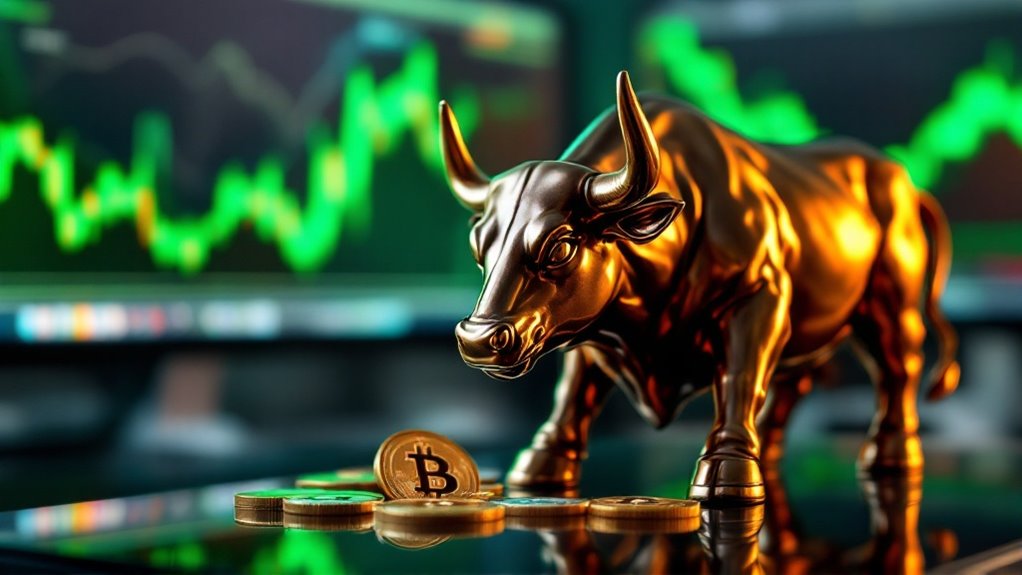MemeCoinCook.com serves up spicy crypto memes and info for entertainment only—this ain’t financial, investment, legal, or professional advice! Whipped up with AI flair, our content might have some half-baked bits, so DYOR before you dive into the crypto pot. NFA, folks—we’re just tossing out ideas, not guarantees. We make no claims about the accuracy, legality, or tastiness of our posts. Sip our content at your own risk! Check our Terms of Use for the full recipe.

What Does Bullish Mean in Crypto?
In crypto, “bullish” means expecting prices to rise—like a bull thrusting its horns upward. Bullish sentiment drives buying activity and market optimism. Traders spot bullish markets through rising prices, higher trading volumes, and positive news coverage. Common bullish strategies include hodling through dips and momentum trading. Technical indicators like RSI and MACD help identify upward trends. This isn’t financial advice—trade at your own risk. Discover proven strategies for steering through these exciting market conditions below.
Understanding Bullish Sentiment in Cryptocurrency Markets

When investors feel optimistic about cryptocurrency prices going up, they’re experiencing what’s known as bullish sentiment. This positive outlook drives market growth as traders expect future gains from their investments.
Unlike bearish sentiment (expecting price drops), bullish attitudes encourage more buying activity. During these periods, investor confidence often leads to increased demand for well-known cryptocurrencies like Bitcoin and Ethereum. Bulls typically employ strategies like buy and hold or purchasing during corrective declines to maximize their returns. The term “bullish” comes from the image of a bull thrusting upward with its horns, symbolizing the upward movement of market prices.
Key Indicators of Bullish Markets
- Rising prices – The most obvious sign investors are feeling good
- Higher trading volumes – More people are jumping in to buy crypto
- Positive media coverage – Good news spreads optimism
Bullish sentiment often emerges from favorable developments like institutional adoption or regulatory clarity. When major companies announce Bitcoin purchases or governments create crypto-friendly policies, investor confidence typically soars.
Technical traders also spot bullish patterns in price charts, signaling potential upward movements.
*This isn’t financial advice—trade at your own risk.*
How to Identify and Navigate Bull Markets
While everyone wants to catch the next big crypto wave, recognizing a bull market takes practice and careful observation.
Key Signs to Watch
Traders look for several clear indicators:
Several clear indicators help traders spot emerging bull markets in cryptocurrency.
- Prices climbing steadily for weeks or months
- Trading volumes increasing alongside price gains
- Positive news dominating crypto headlines
- Even smaller altcoins gaining momentum
Technical Confirmation
Charts reveal the story. Moving averages trend upward. Each price dip gets bought quickly. Higher highs and higher lows form a staircase pattern on graphs. High trading volumes typically accompany these significant price movements, confirming strong market participation. However, traders must remember that short-term downward movements can occur even during strong bull markets.
Market Sentiment Shift
Social media buzzes with optimism. New investors flood in. The “hodl” mentality strengthens as confidence builds. This mirrors traditional markets where investor euphoria can create speculative bubbles that eventually burst.
Smart traders stay alert but cautious. Bull markets don’t last forever. Setting profit targets helps avoid getting caught when sentiment shifts.
*This isn’t financial advice—trade at your own risk.*
Strategies and Tools for Bullish Crypto Trading
Several proven strategies help traders capitalize on bullish crypto markets. Momentum trading catches assets with strong upward trends using RSI and MACD indicators. Swing trading captures gains over days to weeks, while day trading focuses on short-term movements.
Key Technical Tools:
- RSI: Spots overbought/oversold conditions
- MACD: Identifies trend shifts and entry points
- Moving Averages: Tracks overall trend direction
- Bollinger Bands: Shows market volatility
Risk Management Essentials:
- Set stop-loss orders to limit potential losses
- Size positions carefully—don’t bet the farm
- Diversify across multiple crypto assets
- Use trailing stops to secure profits while allowing positions to run during strong uptrends
Popular platforms like Binance, KuCoin, and Bullish offer advanced trading features. Bullish provides perpetual futures for BTC, ETH, and CoinDesk 20 Index with minimal slippage for institutional-grade execution. Each provides different leverage options and liquidity levels for various strategies. Beyond traditional trading, yield farming offers another way to generate returns during bullish periods by providing liquidity to DeFi platforms.
*This isn’t financial advice—trade at your own risk.*
Frequently Asked Questions
How Long Do Typical Crypto Bull Markets Last Compared to Traditional Markets?
Crypto bull markets typically last much shorter than traditional ones.
While traditional market bulls can run for 2.5-3 years, crypto bulls average around 12 months.
Some crypto runs sprint for just a few months, while others might stretch to three years.
The general rule suggests about 250 days for crypto bulls.
Traditional markets enjoy steady climbs, but crypto prefers the rollercoaster approach—faster, wilder, and definitely more exciting.
This isn’t financial advice—trade at your own risk.
What’s the Difference Between Being Bullish on Bitcoin Versus Altcoins?
Like choosing between a sturdy oak and blooming wildflowers, Bitcoin and altcoin bullishness differ markedly.
Bitcoin Bulls:
- Focus on long-term stability and institutional adoption
- Experience gradual, sustained growth patterns
- Less manipulation risk due to massive market cap
Altcoin Bulls:
- Chase innovation and moonshot potential
- See volatile, rapid price swings
- Higher risk but potentially bigger gains
Bitcoin bulls prefer steady climbs while altcoin enthusiasts enjoy the rollercoaster.
*This isn’t financial advice—trade at your own risk.*
Can You Be Bullish Short-Term but Bearish Long-Term?
Yes, investors can absolutely be bullish short-term but bearish long-term. It’s not contradictory—just different timeframes.
Why This Happens:
- Short-term: Riding momentum waves, quick profits
- Long-term: Concerns about sustainability, market bubbles
Think of it like enjoying a sugar rush while knowing the crash is coming. Many traders capitalize on short rallies while preparing for eventual corrections.
Smart money often plays both sides.
*This isn’t financial advice—trade at your own risk.*
How Do Institutional Investors Influence Bullish Crypto Sentiment?
Institutional investors act like whales entering a swimming pool—their presence creates waves everyone feels.
When giants like BlackRock or Goldman Sachs jump into crypto, smaller investors gain confidence. These big players bring massive capital, creating liquidity and stability. Their regulated products (ETFs, ETPs) make crypto accessible to mainstream investors.
About 59% plan significant crypto allocations by 2025. This institutional validation transforms crypto from speculative asset to legitimate investment class.
This isn’t financial advice—trade at your own risk.
What Historical Events Triggered the Strongest Crypto Bull Runs?
The strongest crypto bull runs emerged from perfect storms of events:
- 2013: Early adopters discovered Bitcoin’s potential while infrastructure like exchanges launched.
- 2017: ICO mania created unprecedented hype (everyone wanted lambos).
- 2020-2021: Institutional giants like Tesla jumped in, plus pandemic money printing.
Each run shared common triggers: halving events reducing supply, positive media coverage, and regulatory breakthroughs.
When these align, crypto goes parabolic.
*This isn’t financial advice—trade at your own risk.*
Conclusion
Understanding bullish sentiment helps investors navigate crypto markets with greater confidence and clarity. Whether someone’s watching charts or reading market sentiment, recognizing bull patterns becomes second nature with practice. Smart traders combine technical analysis with fundamental research to make informed decisions. The crypto market rewards patience and knowledge. Remember, even the strongest bulls need rest sometimes. This isn’t financial advice—trade at your own risk.



